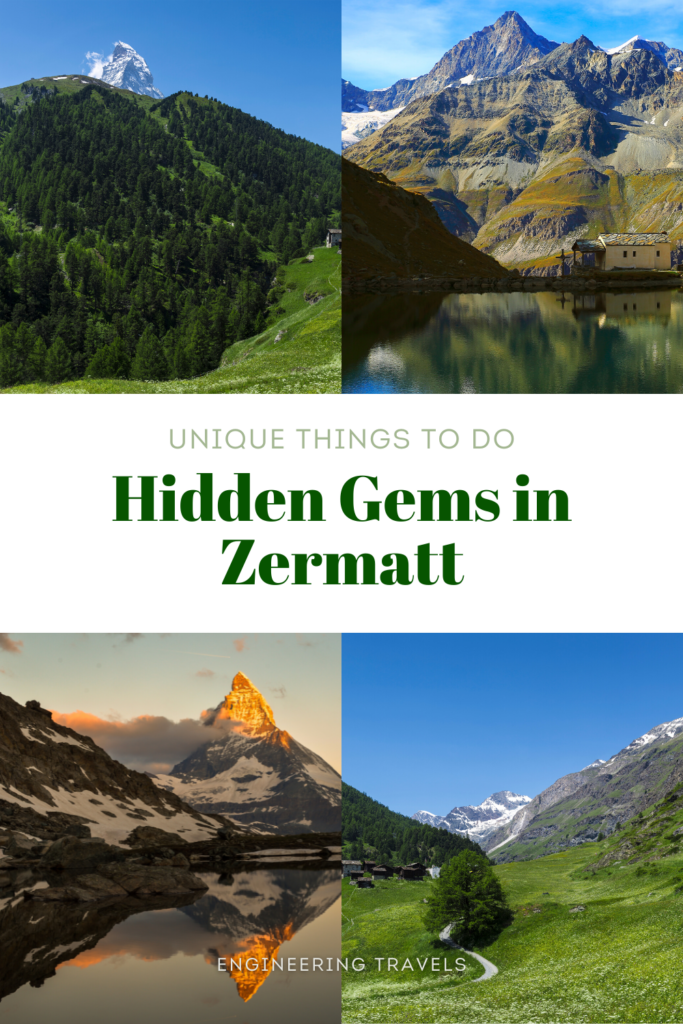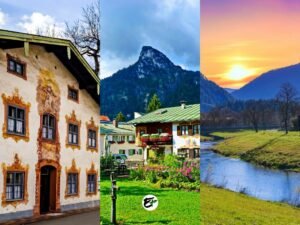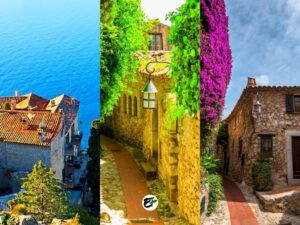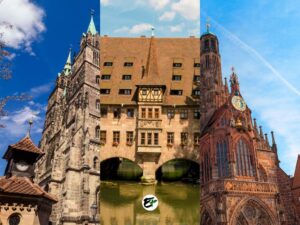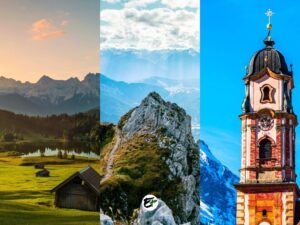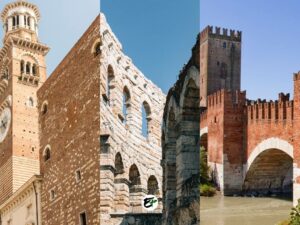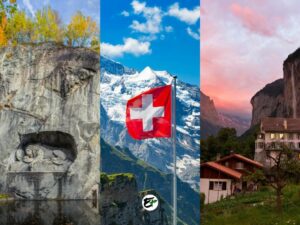Unique Things to Do in Zermatt: 10 Hidden Gems to Discover
Many visitors head straight to Gornergrat or Matterhorn Glacier Paradise for that bucket list experience when they visit Zermatt. Afterward, they leave Zermatt to explore other towns, believing that it is a way to have a more worthwhile journey in Switzerland. In a way, I agree.
However, what many don’t realize is that Zermatt has much more to offer. While not as well-known, there are attractions in Zermatt that are equally amazing, unique, and unforgettable. If you’re planning a trip to Zermatt, these attractions and places of interest are worth considering, especially if you’re someone who enjoys exploring peaceful places like the mountains.
Interestingly, a few of the unusual things and hidden gems that I’ll mention in this post require little effort to reach. They are conveniently located either in the heart of the town or nearby, reachable within a few minutes of hiking. Visiting these attractions can make your trip to Zermatt even more worthwhile. So, let’s get started on discovering each one!
This post contains affiliate links. I may receive a tiny commission at no additional cost to you.
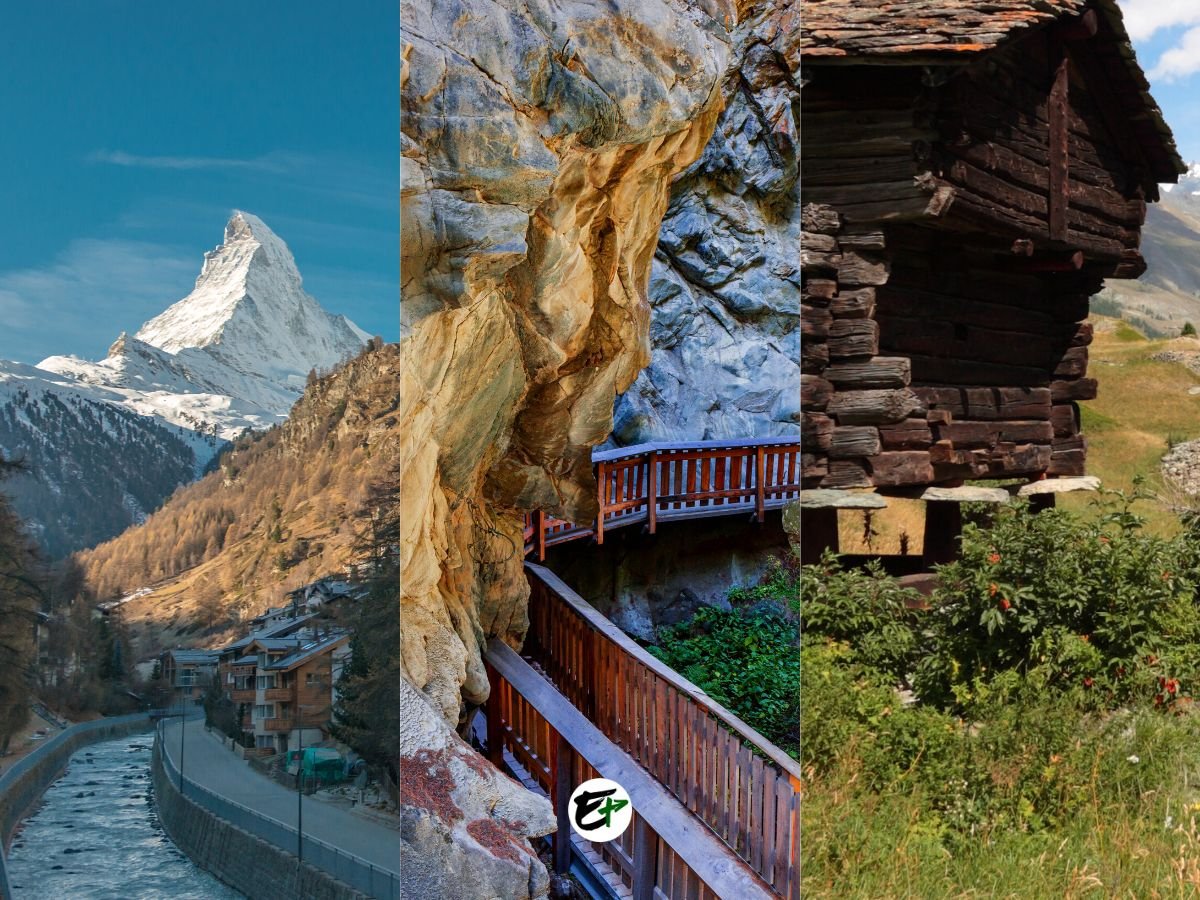
Use the table of contents to skip to topics.
Coming from the opposite side of the globe, I regard Zermatt as a once-in-a-lifetime trip. If you agree, and you still in the planning phase of your visit to Zermatt, reading a guide to Zermatt is a must. This will ensure a more enjoyable and successful trip to this beautiful destination. You might also want to discover the stunning viewpoints in Zermatt. These, together with the hidden gems I’ll share with you in this post, are the reasons why I think Zermatt is an absolutely worthwhile destination.
Staying for a few days in Zermatt? Find the best hotel deals in Zermatt here.
1. Kirchbrücke
Without a doubt, the Matterhorn — the most iconic peak in Switzerland — is what sets Zermatt apart from other beautiful alpine towns. From this village, the Matterhorn’s distinctive, almost perfect pyramid shape dominates the skyline of the Pennine Alps.
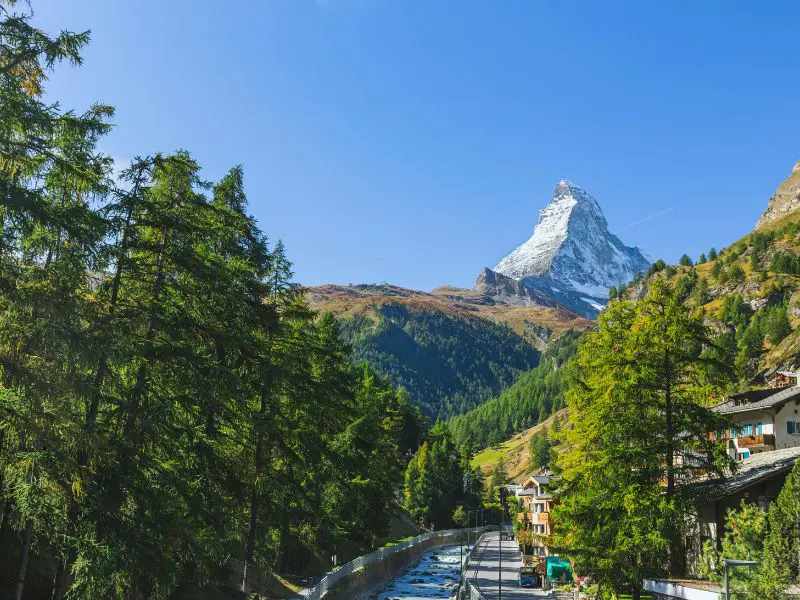
You are right if you are thinking: getting a view of the Matterhorn in Zermatt requires little effort.
A leisurely hike to the elevated parts of the village, like Mürini Hill in its northeastern part, rewards you with awe-inspiring scenery of the Matterhorn towering over the chalet-filled village. Alternatively, you can ride a funicular to Sunnegga, which has a station in the middle of the village, for an even more effortless view of the Matterhorn.
But did you know there’s an even more accessible viewpoint that requires neither hiking nor a cable car ride? It’s Kirchbrücke, a bridge in the heart of Zermatt near the cemetery and Pfarrkirche St. Mauritius. While it’s not a secret destination — most visitors pass by this bridge during their visit — not everyone realizes that it offers a pleasing view of the Matterhorn.
From the view on this bridge, Kirchbrücke can be considered one of the most appealing parts of the village. It serves an unusual yet beautiful spot for observing the Matterhorn. Nestled in the village center, this location will certainly be convenient for observing the Matterhorn at sunrise. This is particularly true if you’re staying at a hotel in the village.
The sight of the Matterhorn bathed in an orangey-pinkish hue during the golden hour, set against the lush trees along the riverbank, is a lovely spectacle. Imagine witnessing this spectacle while being soothed by the sound of the flowing river below.
2. Hinterdorf Street (Hinterdorfstrasse)
When people think of Zermatt, panoramic views of the mountains, breathtaking hikes, and fantastic ski routes often come to mind first. After all, it is a renowned skiing resort and hiking destination. However, many are unaware that Zermatt also has a preserved rustic area, which is a hidden gem, particularly for first-time visitors. This area is known as Hinterdorf Street.
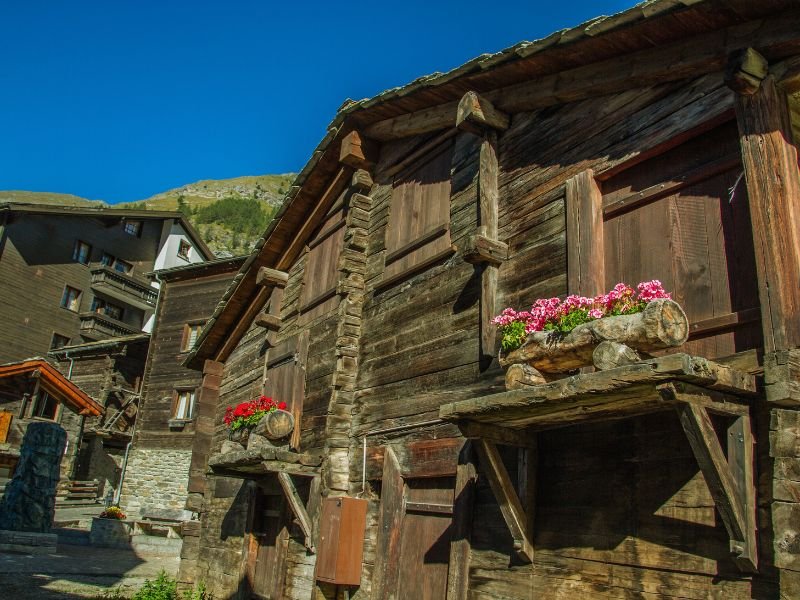
By exploring Zermatt’s highlights and taking a detour to Hinterdorf Street, you’re setting yourself up for a variety of experiences. Your trip will become more than just a nature retreat. It’ll be a unique expedition with a touch of history and discovery of the rustic alpine architecture.
Imagine stepping into a time machine in the Alps and being transported back to the 16th century. That’s exactly what it feels like when you wander down Hinterdorf Street, the oldest part of Zermatt. Here, you’ll find over 30 buildings, each one is a perfect example of the traditional architecture of the upper Valais.
What makes Hinterdorf Street so special? It vividly talks so much about the life of the residents of Zermatt back in the day. As you stroll down the cobbled street, you’ll see buildings made of larch, their roofs laden with heavy slabs of rock.
If we are the same — hailing from a completely different environment (such as a city or a beach town) — you will find Hinterdorf street absolutely captivating.
During your visit, take your time to explore and let your imagination run wild. Don’t forget to bring your camera – there are plenty of picturesque spots to capture. And if you’re interested in learning more about the history and culture of Zermatt, why not join a guided village tour?
Locating Hinterdorf Street is simple. Begin at the heart of the village, at Pfarrkirche St. Mauritius. From there, take the quaint lane known as Englischer Viertel, located between the church park and the Matterhorn Museum. Continue straight until you encounter Fontaine Inderbinen. At this point, look to your left and you’ll find yourself at Hinterdorf Street.
3. The Hamlet of Herbrigg
For those with a burning desire to explore, Hinterdorf Street is just the beginning of the unique and hidden gems that you’ll find in Zermatt that’s about history and architecture. Another one is the Hamlet of Herbrigg.

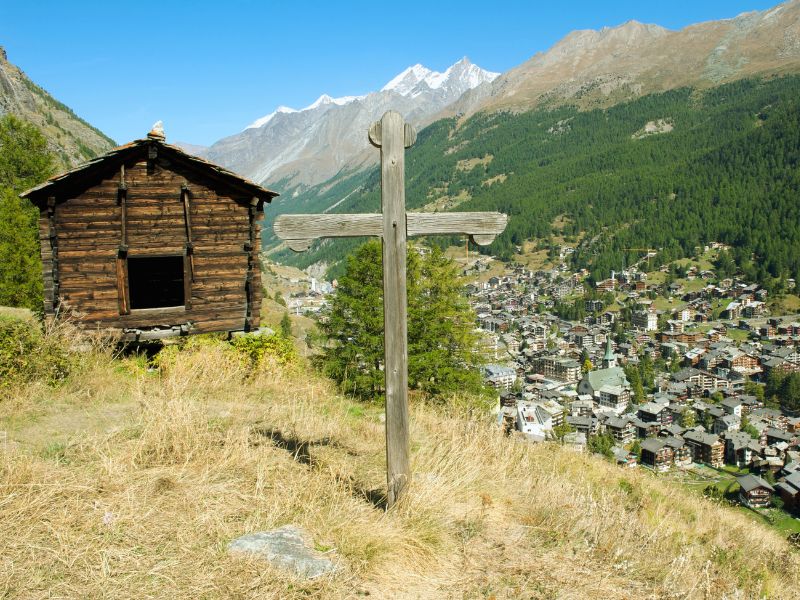
The Hamlet of Herbrigg, a small settlement perched on the slopes at an altitude of 1,754 meters, with a history rooted in farming and agriculture. From its location, visitors are able to take in a panorama overlooking the village of Zermatt.
Herbrigg stands out with its rich history and unique architecture. Picture traditional Walser-style barns, built of larch, balanced on stilts and flat stones to keep out mice. These structures, along with terraced fields that extend up to 2,000 meters, paint a vivid picture of the area’s agricultural past.
When you visit Herbrigg, you can immerse yourself in the area’s alpine flora and observe a large number of bird and butterfly species, including the Apollo butterfly. The hamlet is also steeped in local folklore, with tales of ghosts and the life of the people who once inhabited this place. You can paint the folklore in your imagination when you visit Herbrigg.
This ghost was known for sneezing all the time. The people living in the town got used to this strange sound, but no one was brave enough to find out more. One day, a brave milkmaid working in Herbrigg heard the ghost sneeze. Without thinking, she said “Bless you!”. To everyone’s surprise, the ghost appeared and thanked her, saying “May God bless you, too.”. He explained that he had been waiting for someone to bless him so he could leave the barn.
Another reason to visit the Hamlet of Herbrigg is its idyllic setting. Spending a few moments here allows you to experience tranquility at its finest. Moreover, this hamlet houses the oldest barn in Europe. Seeing it firsthand, you might wonder how a wooden structure has managed to withstand the test of time. As stated on the official Zermatt website, this barn has been standing since 1261.
Wondering how to reach the Hamlet of Herbrigg? It’s conveniently located just above Zermatt’s ZenStecken bus station. However, you can also make your way directly to Herbrigg from the center of Zermatt. Here’s a step-by-step guide:
- Start at the Church of Saint Mauritius and head south, following the direction of the iconic Matterhorn.
- When you reach the first fork in the road, take the path on the right.
- Continue walking and you’ll soon come across another fork. Once again, choose the path on the right which will lead you to Schälpmattgasse.
- As you stroll along Schälpmattgasse, you’ll notice a stairway leading upwards. Take these stairs and you’ll find yourself on Herbriggweg, the path that leads directly to Herbrigg.
- Follow Herbriggweg and in just about 15 minutes, you’ll find yourself in the charming Hamlet of Herbrigg.
4. The Hamlet of Zmutt
In addition to the quaint Hamlet of Herbrigg, Zermatt has another hamlet, which, without a doubt, is a hidden gem — the Hamlet of Zmutt. Nestled deep within the valley, it’s a one-hour hike from Zermatt.
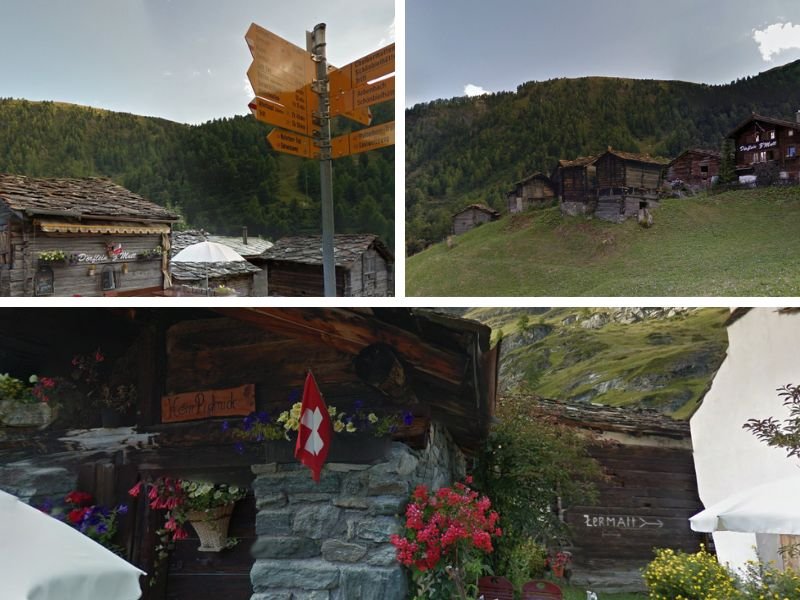
As you might have expected: in contrast to Zermatt village, this hamlet doesn’t see many tourists. There are no buses and no signs of commercialization, just the simplicity of life. It feels as though time has paused here, a sensation that grows stronger when you begin exploring the traditional wooden houses.
Fun fact, the houses in the Hamlet of Zmutt have silently observed over five hundred years of history. That’s according to the official website of Zermatt!
With nothing but the forests, mountains, and alpine pastures surrounding it, the Hamlet of Zmutt is undoubtedly the place to be if you’re looking for the most idyllic settlement in Zermatt. It is the kind of place you’d seek out when you need a respite from life’s stresses.
Beyond the tranquility and rustic scenes, it’s when you stroll around the hamlet and meander through its narrow streets that you’ll understand what sets this place apart: The hamlet’s buildings, which include houses, barns, and a chapel, number less than 40. They’re closely nestled together, as if safeguarding each other from nature’s caprices.
During your visit, make sure to discover the unique depiction of the Ways of the Cross in the white chapel. And don’t forget to photograph the cluster of houses with the chapel in the background.
Finally, after all the exploration, you can visit the quaint shops and beer gardens in the heart of the hamlet. These spots offer a chance to rest and unwind before hiking back to Zermatt.
5. Stellisee
For those wishing to immerse themselves in the natural beauty of Zermatt, with an incredible view of the Matterhorn, the high-altitude alpine lakes are the must-see destinations. They offer not only unparalleled tranquility but also fantastic opportunities for photography.
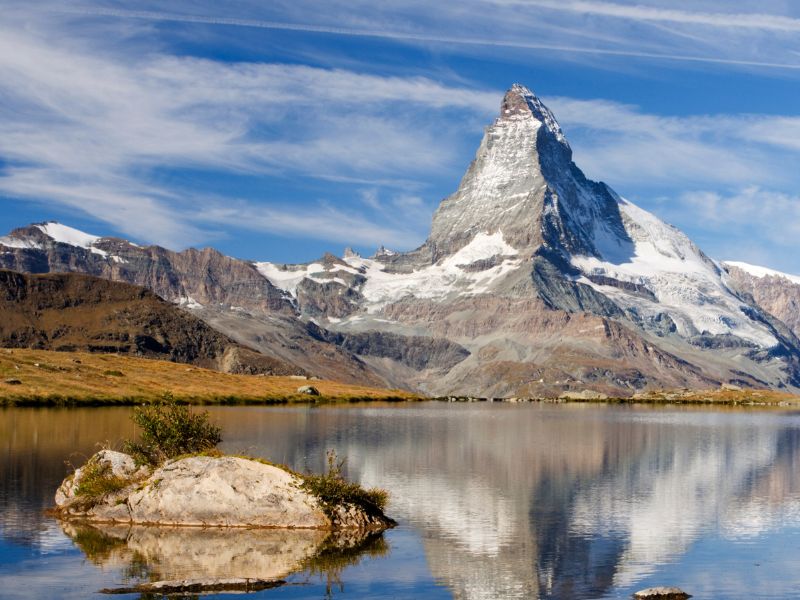
On calm weather days, the surface of these lakes transforms into a giant mirror. From a certain angle, you can capture an inverted image of the Matterhorn reflected on their surface.
Zermatt and the Pennine Alps are scattered with these picturesque lakes. Riffelsee is the most famous and frequently photographed. However, if we were to highlight an alpine lake as a hidden gem (particularly to first timers), it would undoubtedly be Stellisee. Photographers often know about Stellisee, and you can see their shots on Instagram or other photo-sharing platforms. But, indeed, Stellisee remains an undiscovered gem for many others.
In a way, Stellisee offers similar experience with other alpine lakes in Zermatt. However, the view from Stellisee is unique from other lakes in Zermatt because it has a perfect alignment with Matterhorn’s Hornli ridge. In my opinion, the photo of Matterhorn on the box of Toblerone matches the appearance of the mountain from this spot.
How to get to Stellisee? You could take the funicular to Sunnegga, then hop on a gondola to Blauherd. From there, it’s just a 15 to 20-minute walk to the lake.
Once you’re at the lake, there are several things to do. You could take a break, enjoy the view, or even take some photos. With a bit of luck, you might spot some Valliser black-nosed sheep grazing by the lake.
If you’re in the mood for more adventure, there are other nearby spots to explore. You could visit Fluhalp for some refreshments; the Rothorn Viewpoint, offering additional views of the mountains; and Grindjisee which is another hidden gem of a lake with a view of the Matterhorn.
6. Schwarzsee
Not all lakes in Zermatt have a view of the Matterhorn. However, some, like Schwarzee, present a scene reminiscent of your favorite fantasy novels.
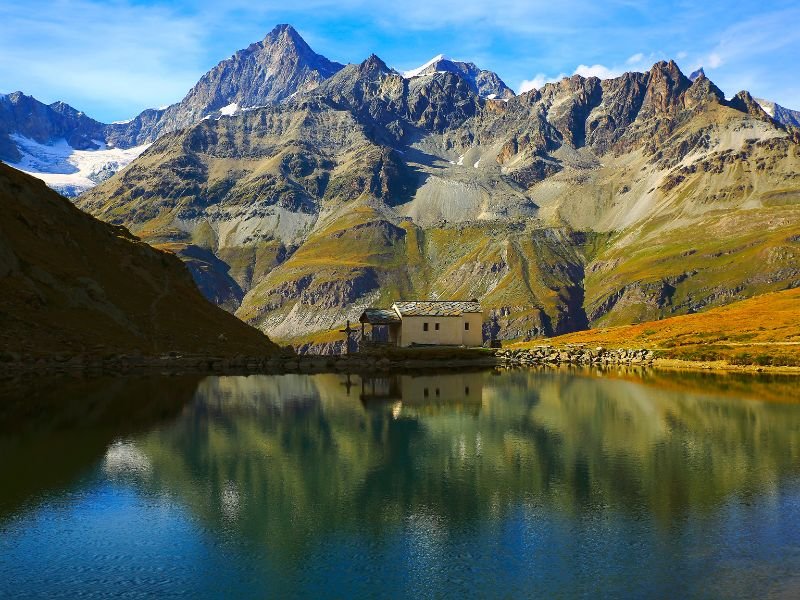
Actually, Schwarzee isn’t particularly hidden, especially for hikers. This lake is located along the Matterhorn Glacier Trail. Despite this, Schwarzee remains a lesser-known spot for many tourists visiting Zermatt. It’s a hidden gem in its own right.
With the Maria zum Schnee chapel at its shores, Schwarzsee stands out as a unique destination in Zermatt. Did you know that this chapel is important to people who climb the Matterhorn mountain? They visit the chapel to say thank you after they safely reach the top and come back down.
If you’re a photographer, Schwarzsee is a spot you won’t want to miss, especially on a calm, clear day.
Make your way to the southern part of the lake. Here, you can capture the Maria zum Schnee chapel, mirrored beautifully on the lake’s surface. From there, you’ll also have a clear view of the awe-inspiring peaks of Zinalrothorn, Wellenkuppe, and Ober Gabelhorn.
How to get to Schwarzee? Start your journey in the charming village of Zermatt. Hop on a gondola that will whisk you away to Furi. Once you reach Furi, you’ll switch to another gondola. This one takes you straight to Schwarzsee. The whole gondola journey should take around 18 minutes.
7. Charles Kuonen Suspension Bridge
Zermatt is surrounded by attractions that are not only breathtaking but also technically impressive. Looking at everything from the cable cars to the trains that climb mountains, it’s amazing to see how much the Swiss love to build things.
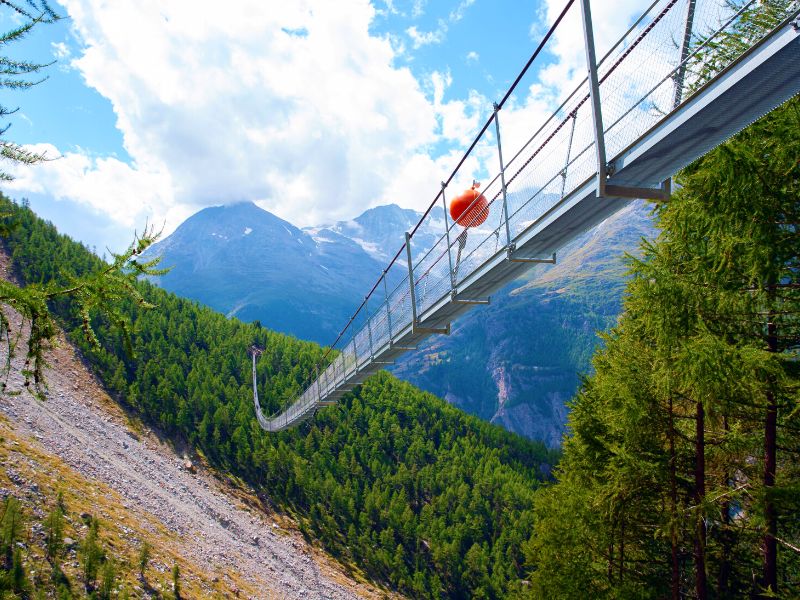
Another notable attraction to visit in this regard is the Charles Kuonen Suspension Bridge. This is the longest bridge of its kind anywhere in the world. Just walking on this bridge is something unique you can do in Zermatt.
Of course, what’s amazing about this bridge is its sheer size. It stretches over 494 meters, which is like five football fields end to end! And at its highest point, it’s 85 meters above the ground. That’s nearly as tall as the Statue of Liberty!
Do you want to visit the bridge? The Charles Kuonen Suspension Bridge is nestled in Randa, Switzerland. To get there, you can take a train from Zermatt to Randa. The journey is relatively short.
Once you arrive, you’ll find a hiking trail that leads up the mountain. This trail is marked with yellow signs, guiding you towards either Europahütte or the Charles Kuonen Suspension Bridge. The hike itself takes about 1.5 to 2 hours and is considered to be of intermediate difficulty.
There are a few things you should know before you set off. Firstly, the bridge is closed during winter, so it’s best to plan your visit for the spring or summer. Secondly, the bridge might not be suitable for individuals who experience dizziness or have a fear of heights. This is because the bridge tends to sway with each step and can also move in the wind.
For more information, kindly check the official website of Europaweg.
8. Arbenbach Waterfall
Zermatt is a haven for natural attractions. Mountains, lakes, and glaciers are plentiful, and for those with a keen eye, waterfalls can also be found. However, unlike Lauterbrunnen, which is known for its abundance of waterfalls, Zermatt has only a few, most of which are hidden in secluded areas.

If waterfalls pique your interest, the Arbenbach Waterfall along Zermatt Hohbalmen Loop hike should be at the top of your list. This waterfall is literally a “hidden” gem. And while it is tucked away in the far corner of the valley, the journey to reach it is rewarding in itself. Most importantly, from the Arbenbach Waterfall, a unique view of the Matterhorn unfolds before your eyes.
Good to know: Hamlet of Zmutt is also located along Zermatt Hohbalmen Loop. For more information to get to Arbenbach Waterfall and Zermatt Hohbalmen Loop, you can check the PDF below.
9. Gorner Gorge
Zermatt is renowned for its spectacular views of 4000-meter peaks. Yet, it also offers amazing wonders that lie beneath the towering peaks. For a change in scenery, consider visiting Gorner Gorge. It is an excellent place to experience the unusual beauty of Zermatt.
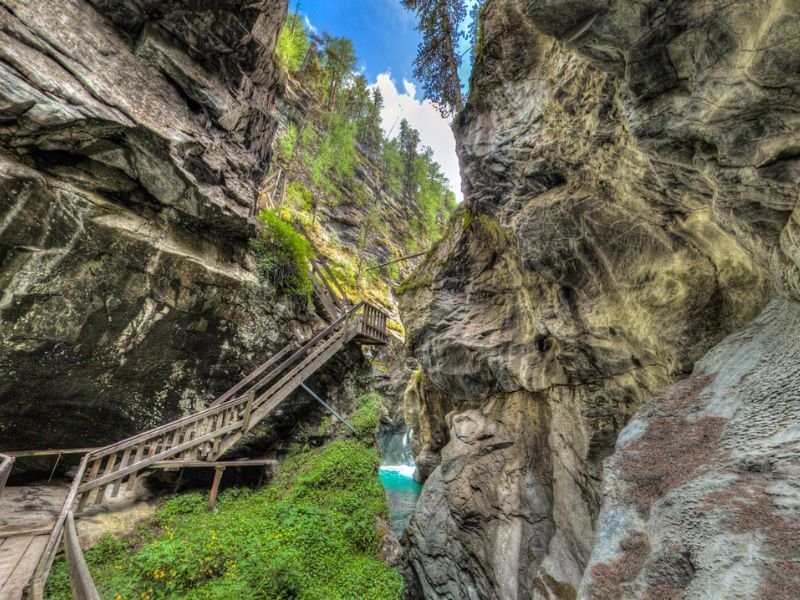
In a nutshell, the Gorner Gorge is a natural formation carved by the Gornervispe waters since the last ice age. The rock inside is greenish serpentinite, about 220 million years old. When you visit, you can find wooden walkways between cliffs, letting you explore the spectacular rock formations above turquoise water of the river.
To get there from Zermatt, it’s a 15-20 minute walk from the center, near the Matterhorn Glacier Paradise cable car base station. Alternatively, take a shuttle bus to Zermatt, Matterhorn Glacier Paradise stop, then walk about 750m to the entrance.
You can explore the gorge on foot or hire a mountain guide for a three to four-hour tour. The best time to visit is from late June through mid-October. If possible, visit between 3pm and 4pm from mid-October, when the water turns turquoise due to the light conditions.
For more information, please check the official website of Zermatt.
10. Iglu-Dorf
In Zermatt, even a stay in an accommodation can be an absolutely unique experience. Iglu-Dorf stands as the best example. With its name, this igloo hotel, restaurant, and bar needs no further introduction! Its well-designed and decorated rooms and the whirlpool inside an igloo room with a direct view of the Matterhorn from the window are a highlight!

Perched at 2,727 m above sea level, Iglu-Dorf Zermatt is more than just a place to stay, relax, and take in stunning views of the Matterhorn. It offers unique activities too! From carving your own snow sculpture to building your own igloo, fun awaits you here. If you’re traveling in a group, Iglu-Dorf can arrange arctic winter games for you.
Are you a food enthusiast? You might enjoy eating fondue at an outdoor bar. The cheese is locally made, adding to the authenticity of the experience.
However, remember that Iglu-Dorf is a seasonal attraction. It usually opens for the winter season from December until April. So, if you’re planning a visit, remember to check the opening dates and book in advance. For more information, visit the official website of Iglu-Dorf.
More Destination in Switzerland Aside from Zermatt
So, we’ve explored the unique things to do in Zermatt and its hidden gems. They are quite impressive, aren’t they? Especially Iglu-Dorf, and the hamlets of Zmutt and Herbrigg!
If you’re considering another destination in Switzerland after Zermatt, Lauterbrunnen or Interlaken could be on your list. There’s a wealth of activities in these areas. For instance, you could spend three full days in Lauterbrunnen and a week in Interlaken.
In my opinion, these two locations are strong contenders with Zermatt for the title of the most beautiful place in Switzerland! These areas also have quaint villages and mirror-like lakes that are worth discovering.
Save it on Pinterest.

